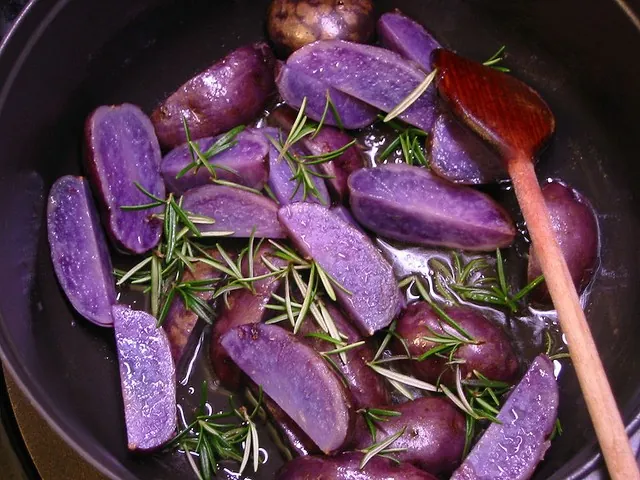Blog
3 Reasons to make Purple Potatoes your go to Potato
By Lisa Kaschmitter, Nutritionist
As a born and raised Idahoan, potatoes have always been a part of daily life, even a part of multiple meals during the day. Potatoes have a reputation for being one of the more versatile foods. They are an inexpensive carbohydrate, packed with fiber, potassium and protein. I know Idaho is not alone in their celebration of potatoes because they are a staple on tables in Arizona as well!

Photo: https://farm1.staticflickr.com/2/3698737_9bd66bc14e_z.jpg
Although potatoes range from red to gold, many people are most familiar with the russet potato, as it can be prepared in many different ways. Mashed, chopped into home fries, sliced into French fries, boiled and added to a creamy potato salad or thinly sliced into rounds, covered with cheese and made into an au gratin side dish, we all have a favorite way to eat this versatile food. Potatoes bring a great range of vitamins and minerals to the dinner table that is important for health.
Although I have spent my life surrounded by potatoes, one day I was stopped in my tracks at the grocery store by a potato I didn’t recognize. It was dark purple in color and was on the shelf above the red potatoes that I had been purchasing for months. Being the potato fan that I am, I had to pick some up.
When I began researching the purple potato I discovered that they are very similar to the russet potato in the many ways it can be prepared, but the purple potato hides important added health benefits that makes them my new favorite go to potato for all my favorite dishes.
What is so great about the purple potato?
- Antioxidants: The purple coloring of the purple potato is a sign of its high antioxidant levels. Anthocyanin is responsible for blue/purple colors in foods.1 This pigment adds an antioxidant level in purple potatoes that is four times the antioxidant levels in russet potatoes.2 It is believed that anthocyanin is also responsible for heart healthy benefits and healthy blood pressure levels.1,3
- Fiber: They contain double the fiber of russet potatoes. Although fiber levels in both types of potatoes are rather low, (1/2 cup russets: 1 gram, ½ cup purple potatoes: 2 grams), it is an important difference.2 Increasing your intake of fiber from plant sources is essential for a healthy body. Potatoes are a form of soluble fiber that plays a role in removing cholesterol from the blood.4 The best way to take advantage of this fiber source is to utilize the potato skin.3 The skin contains the most fiber and therefore it is better let on and enjoyed when possible.
- Lower Blood Pressure: As was mentioned in the first reason, the blood pressure lowering qualities of purple potatoes have been studied with positive results. In one such study people who saw the benefits were required to eat 6 to 8 potatoes for two meals a day.3 Although, this seems like a lot of food, it only added to approximately 218 calories per day and saw their blood pressure reading lowered by 4.3 percent, while they saw a 3.5 percent reduction in systolic blood pressure.3
These unique potatoes come in many varieties, my favorite being the Purple Viking, and they were originally cultivated in the South American countries of Peru and Bolivia.2 Cooking these antioxidant filled potatoes is just as easy as using the russet potato and the taste is identical. Not only will is it fun to serve something that looks so different, everyone will be able to enjoy the extra boost to their antioxidant level and their daily fiber intake.
If you want to know more about purple potatoes, check out our previous blog: The Scoop on Purple Potatoes!
References
- Glover BJ, Martin C. Anthocyanins. Current Biology. March 2012; 22(5): R147-R150. doi: 10.1016/j.cub.2012.01.021
- Makkieh K. Purple Potatoes Nutrition Facts. SFGATE. http://healthyeating.sfgate.com/purple-potatoes-nutrition-2182.html Accessed November 9, 2015.
- Vinson JA, Demkosky CA, Navarre DA, Smyda MA. High-Antioxidant Potatoes: Acute in Vivo Antioxidant Source and Hypotensive Agent in Humans after Supplementation to Hypertensive Subjects. J. Agric Food Chem. January 2012; 60(27): 6749-6754. doi: 10.1021/jf2045262
- Why is fibre important? NHS Web site. http://www.nhs.uk/chq/pages/1141.aspx?categoryid=51 Updated: May 3, 2015. Accessed November 9, 2015.
















